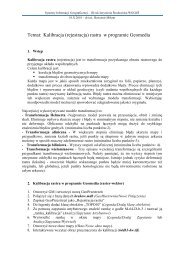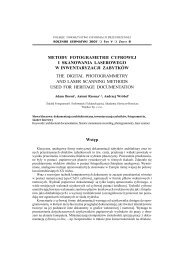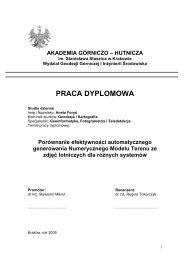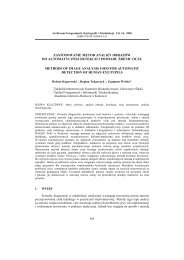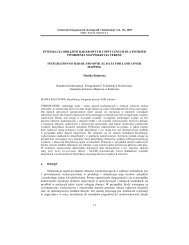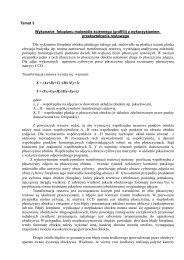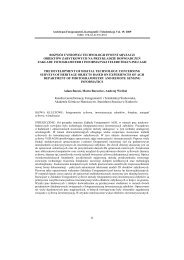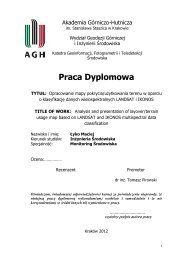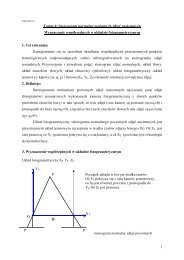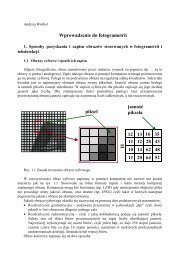Praca Dyplomowa - Photogrammetry and Remote Sensing - AGH
Praca Dyplomowa - Photogrammetry and Remote Sensing - AGH
Praca Dyplomowa - Photogrammetry and Remote Sensing - AGH
You also want an ePaper? Increase the reach of your titles
YUMPU automatically turns print PDFs into web optimized ePapers that Google loves.
THEORETICAL BACKGROUND<br />
Single point scanners<br />
The scanner uses only one single ray beam projection <strong>and</strong> Camera sensor receives only one<br />
point at the time. The point is acquired on the intersection ray beam with an object that the ray<br />
meets. The Imaging lens may differ, for example there may be only one lens; or one lens with<br />
dual aperture mask( inserted next to the diaphragm of the lens creates two spots on CCD<br />
detector <strong>and</strong> a unique peak-position/ separation relationship); or two lenses on both sides of<br />
the project. These additional components give better accuracy.<br />
Slit scanners<br />
The principle is quite similar to single point scanners, though the projector generates laser<br />
plane instead of only one ray. This method gives more information at the time where whole<br />
profile may be received from one scan. The main inconvenience of these scanners is the<br />
compromise between the field of view <strong>and</strong> depth resolution. The other disadvantage is their<br />
relatively poor immunity to ambient light. Some improvements have been done <strong>and</strong> indoor<br />
acquisition is relatively good, but outdoors there might occur some problems.<br />
Pattern projection scanners; structured-light<br />
The projector generates a light pattern (no laser): moiré patterns, circular or line profiles<br />
(horizontal or vertical). “The most popular method use binary coded orphases shift fringe<br />
patterns. Grey-code binary images use multiple frames with increased resolution to encode a<br />
pixel on the CCD with its corresponding range. Subpixel resolution is obtained by detecting<br />
the edge transitions in the highest resolution image. Other methods use sinusoidal phase<br />
encoding the measure range.” (Blais, 2004) In practise, the more frames are used the better<br />
accuracy. These scanners are popular as well, because of low-cost projectors <strong>and</strong> full 3D<br />
volume can be acquired quickly in just few video frames. Disadvantage in comparison to strip<br />
scanners is smaller depth of view. Also, there might occur defocus (when the e.g. image is out<br />
of focus) “of the projected pattern due to fact that a larger projector lens is needed to collect<br />
as much light as possible from the light course.“ (Blais, 2004). Figure 2.12 below illustrates<br />
Pattern projection principle.<br />
Figure 2.12 System setup with one bar pattern <strong>and</strong> one camera; example of structured-light<br />
scanning (http://www.rob.cs.tu-bs.de/en/research/projects/shape/)<br />
24




